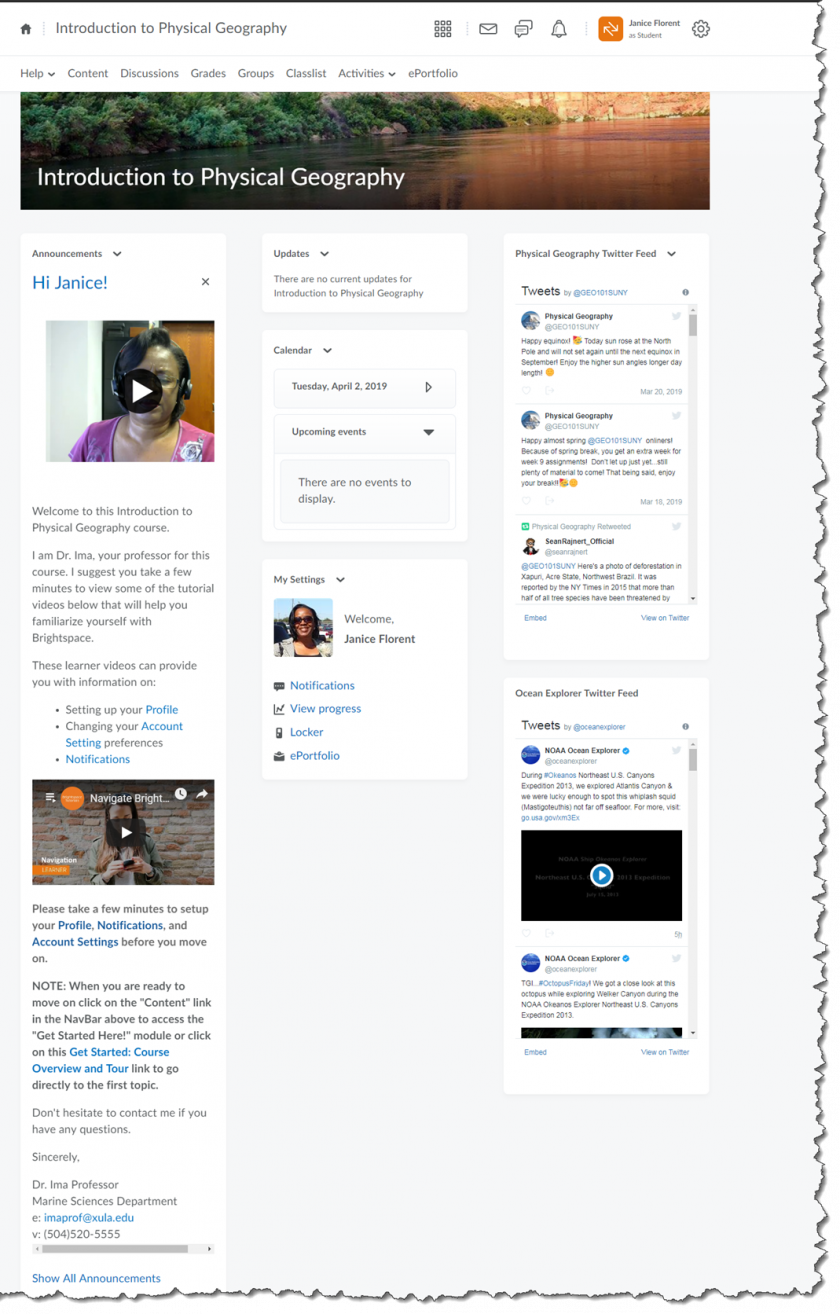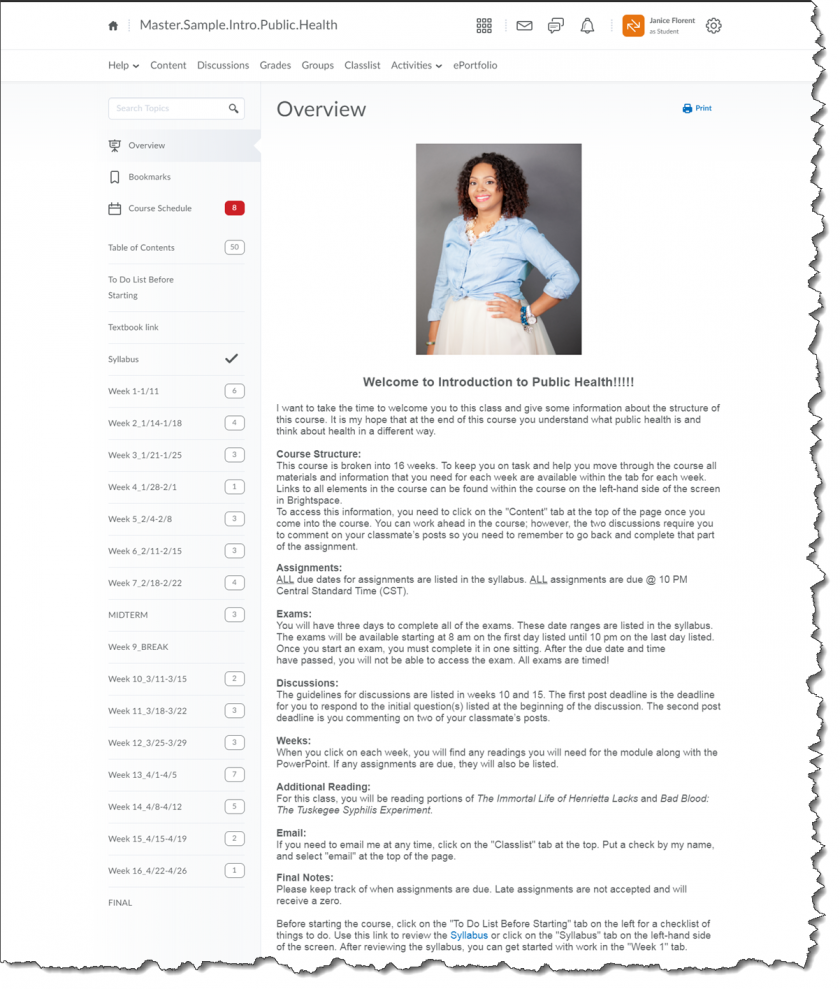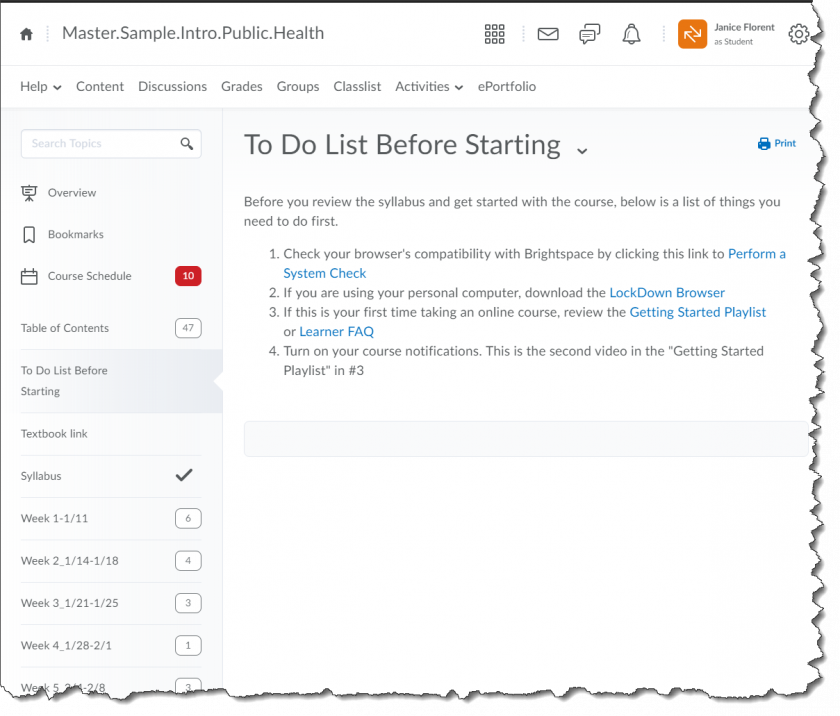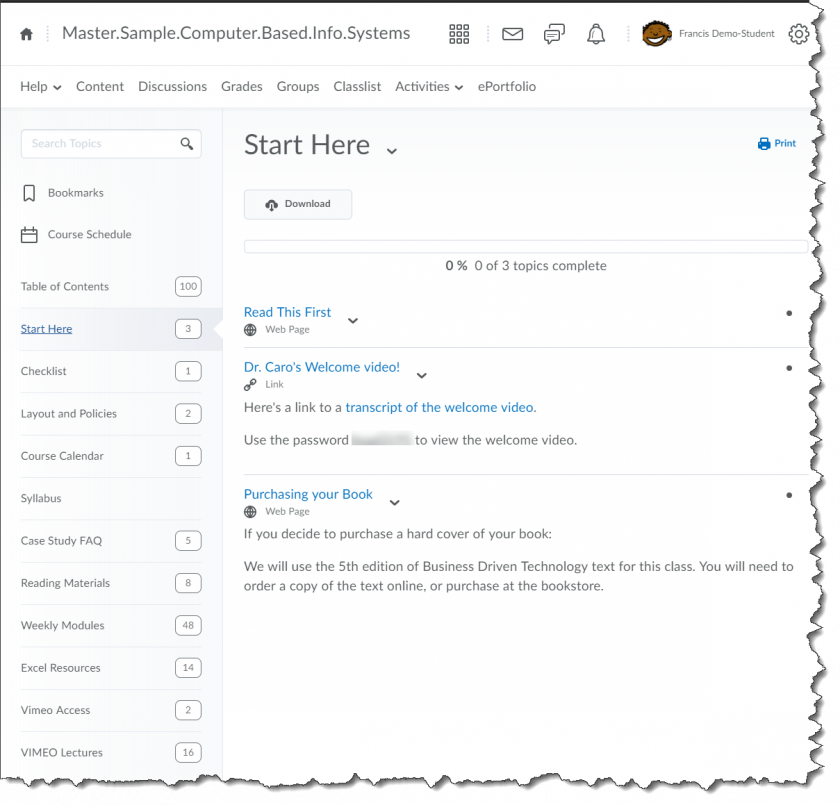QM 1 - Course Examples: Difference between revisions
No edit summary |
No edit summary |
||
| (24 intermediate revisions by the same user not shown) | |||
| Line 1: | Line 1: | ||
==Course Overview and Introduction== | ==Course Overview and Introduction== | ||
===Example 1 - Physical Geography Course: Home Page=== | |||
This is an example of the course home page in a sample Introduction to Physical Geography online course. An announcement on the course homepage welcomes students to the course and provides instructions on how to get started. | |||
[[File:Introduction-to-Physical-Geography-Homepage-1198.png|840px]] | |||
===Example 2 - Physical Geography Course: Get Started Here Module=== | |||
This is an example of a Get Started Here module in a sample Introduction to Physical Geography online course. This module gives students a course overview and tour. Notice one of the activities in the Get Started Here module is introductions. The instructor has introduced herself and setup a discussion forum where students are asked to introduce themselves to the class. The introductions help to humanize the online course. The module ends with instructions on what to do next. | |||
[[File:Get-Started-Here-Intro-Physical-Geography-1687.png|840px]] | |||
===Example | ===Example 3 - Public Health Course: Course Overview=== | ||
The Course Overview in this sample Introduction to Public Health online course welcomes the students to the course and provides information about the structure of the course. The instructor has included a picture to help humanize the course. The Overview ends with instructions on what the students should do next. | |||
[[File: | [[File:Intro-Public-Health-Overview-1202.png|840px]] | ||
===Example 4 - Public Health Course: To Do List Before Starting Module=== | |||
This To Do List Before Starting module in this sample Introduction to Public Health online course provides students with important information to help them get started. The instructor suggests students setup their notifications to help them stay up to date with what's going on in the course. | |||
[[File:Intro-Public-Health-ToDo-1st-1209.png|840px]] | |||
===Example 5 - Public Health Course: Week 2 Module=== | |||
This is an example of a Week 2 course activities module in a sample Introduction to Public Health online course. The course content is organized by weeks. The module for each week starts with a TO DO List so that students know what they have to do each week. Notice one of the activities in week 2 is student introductions, where students are asked to introduce themselves to the class. These introductions help to humanize the online course. | |||
[[File:Intro-Public-Health-week2-1202.png|840px]] | |||
[ | ===Example 6 - Elementary French: Start Course Information Module=== | ||
This is an example of a START-Course Information module in a sample Elementary French online course. The Start-Course Information module provides students with information on how to contact the instructor, technical support, syllabus, course calendar, accessibility information, disaster preparedness, privacy, and copyrights. Clear instructions inform the students about when to expect a response from the instructor. The welcome video and the introductions activity helps to humanize the course. The ''EVERYTHING OK SO FAR?'' topic uses a discussion forum for introductions. A [https://cat.xula.edu/food/brightspace-tip-54-quicklinks/ quicklink] to the discussion forum is provided in the instructions so that the students can go directly to the discussion forum. | |||
[[File:Elementary-French-Start-1209.png|840px]] | |||
===Example 7 - Computer Based Information Systems: Start Here Module=== | |||
This is an example of a Start Here module in a sample Computer Based Information Systems online course. The Start Here module includes a Read This First topic which gives students important information they will need to be successful in the course. A welcome message video from the instructor helps to humanize the online course. | |||
[[File:Computer-Based-Info-Sys-Start-Here-1209.png|840px]] | |||
===Example | ===Example 8 - Computer Based Information Systems: Course Preparation Checklist=== | ||
This is an example of a course preparation checklist in a sample Computer Based Information Systems online course. Using Brightspace's Checklist tool makes it easy for the instructor to provide a [https://cat.xula.edu/food/brightspace-tip-54-quicklinks/ quicklink] to course content that is inside or outside of the course. Students can go directly to the content for the checklist item. Each checklist item includes a due date. Students will see due dates when they look at entries in the course calendar. The due dates help students to stay on track. | This is an example of a course preparation checklist in a sample Computer Based Information Systems online course. Using Brightspace's [https://cat.xula.edu/food/brightspace-tip-21-checklists-and-self-assessments-training-recap/ Checklist tool] makes it easy for the instructor to provide a [https://cat.xula.edu/food/brightspace-tip-54-quicklinks/ quicklink] to course content that is inside or outside of the course. Students can go directly to the content for the checklist item. Each checklist item includes a due date. Students will see due dates when they look at entries in the course calendar. The due dates help students to stay on track. | ||
[[File:Computer-Based-Info-Sys-Prep-Checklist-1202.png|840px]] | [[File:Computer-Based-Info-Sys-Prep-Checklist-1202.png|840px]] | ||
===Example 9 - Introduction to Psychology Course: Get Started Here Module=== | |||
This is an example of a Get Started Here module in a sample Introduction to Psychology online course. This module has links to instructor information, course tour, syllabus, technology requirements and support. The module ends with a link to help students move on to Chapter 1. | |||
[[File:Intro-Psyc-Get-Started-Here.png|840px]] | |||
===Example 10 - Introduction to Psychology Course: Syllabus=== | |||
This is an example of a syllabus in a sample Introduction to Psychology online course. The syllabus gives detailed information about the instructor, communications with the instructor, course philosophy, attendance policy, course requirements, grading, tips for success, and the course schedule. | |||
[[File:Intro-Psyc-Syllabus.png|840px]] | |||
{{OTRfooter}} | {{OTRfooter}} | ||
Latest revision as of 05:29, 24 October 2020
Course Overview and Introduction
Example 1 - Physical Geography Course: Home Page
This is an example of the course home page in a sample Introduction to Physical Geography online course. An announcement on the course homepage welcomes students to the course and provides instructions on how to get started.
Example 2 - Physical Geography Course: Get Started Here Module
This is an example of a Get Started Here module in a sample Introduction to Physical Geography online course. This module gives students a course overview and tour. Notice one of the activities in the Get Started Here module is introductions. The instructor has introduced herself and setup a discussion forum where students are asked to introduce themselves to the class. The introductions help to humanize the online course. The module ends with instructions on what to do next.
Example 3 - Public Health Course: Course Overview
The Course Overview in this sample Introduction to Public Health online course welcomes the students to the course and provides information about the structure of the course. The instructor has included a picture to help humanize the course. The Overview ends with instructions on what the students should do next.
Example 4 - Public Health Course: To Do List Before Starting Module
This To Do List Before Starting module in this sample Introduction to Public Health online course provides students with important information to help them get started. The instructor suggests students setup their notifications to help them stay up to date with what's going on in the course.
Example 5 - Public Health Course: Week 2 Module
This is an example of a Week 2 course activities module in a sample Introduction to Public Health online course. The course content is organized by weeks. The module for each week starts with a TO DO List so that students know what they have to do each week. Notice one of the activities in week 2 is student introductions, where students are asked to introduce themselves to the class. These introductions help to humanize the online course.
Example 6 - Elementary French: Start Course Information Module
This is an example of a START-Course Information module in a sample Elementary French online course. The Start-Course Information module provides students with information on how to contact the instructor, technical support, syllabus, course calendar, accessibility information, disaster preparedness, privacy, and copyrights. Clear instructions inform the students about when to expect a response from the instructor. The welcome video and the introductions activity helps to humanize the course. The EVERYTHING OK SO FAR? topic uses a discussion forum for introductions. A quicklink to the discussion forum is provided in the instructions so that the students can go directly to the discussion forum.
Example 7 - Computer Based Information Systems: Start Here Module
This is an example of a Start Here module in a sample Computer Based Information Systems online course. The Start Here module includes a Read This First topic which gives students important information they will need to be successful in the course. A welcome message video from the instructor helps to humanize the online course.
Example 8 - Computer Based Information Systems: Course Preparation Checklist
This is an example of a course preparation checklist in a sample Computer Based Information Systems online course. Using Brightspace's Checklist tool makes it easy for the instructor to provide a quicklink to course content that is inside or outside of the course. Students can go directly to the content for the checklist item. Each checklist item includes a due date. Students will see due dates when they look at entries in the course calendar. The due dates help students to stay on track.
Example 9 - Introduction to Psychology Course: Get Started Here Module
This is an example of a Get Started Here module in a sample Introduction to Psychology online course. This module has links to instructor information, course tour, syllabus, technology requirements and support. The module ends with a link to help students move on to Chapter 1.
Example 10 - Introduction to Psychology Course: Syllabus
This is an example of a syllabus in a sample Introduction to Psychology online course. The syllabus gives detailed information about the instructor, communications with the instructor, course philosophy, attendance policy, course requirements, grading, tips for success, and the course schedule.


















